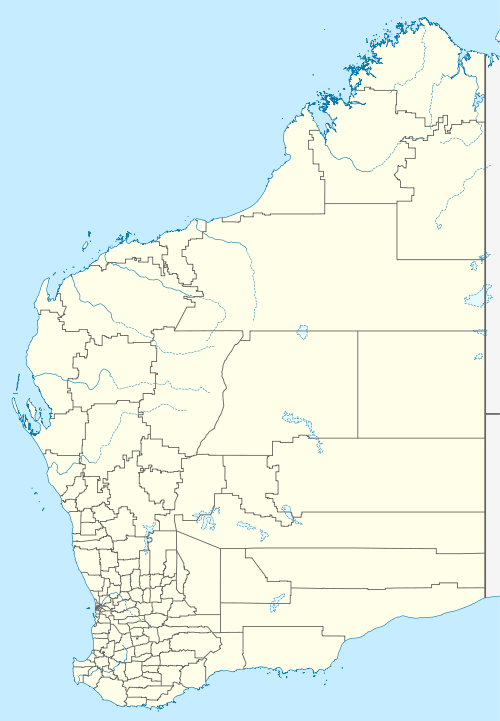Eyre Bird Observatory
Eyre Bird Observatory is an educational, scientific and recreational facility in the Nuytsland Nature Reserve, Western Australia. Cocklebiddy is the nearest locality on the Eyre Highway, 49 km (30 mi) to the north. Sandwiched between the Nullarbor Plain to the north and the Great Australian Bight to the south, it lies in one of the least populated places on the Australian continent. It was established in 1977 by Birds Australia in the disused Eyre Telegraph Station as Australia's first bird observatory, to provide a base for the study and enjoyment of the birds of the area.
| Eyre Bird Observatory | |
|---|---|
 Eyre Bird Observatory Location of Eyre Bird Observatory in Western Australia | |
| General information | |
| Type | Heritage listed building |
| Location | Great Australian Bight, Western Australia |
| Coordinates | 32°14′47″S 126°18′06″E |
| Type | State Registered Place |
| Designated | 28 November 2003 |
| Reference no. | 16522 |

Western Australia's official lowest temperature of −7.2 °C (19.0 °F) was recorded at Eyre Bird Observatory on 17 August 2008.[1]
History
During their nearly 2,000-mile (3,200 km) 1841 journey overland from Adelaide to Albany, 26-year-old Edward John Eyre and his party - companion John Baxter and three Aboriginal men - found fresh water 2 metres (6.6 ft) beneath a coastal sand dune, and camped there for a month, recovering from severe dehydration and exhaustion. This location became known as Eyre's Sand Patch.[2][3]
When the Inter-Colonial Telegraph Line reached the Patch in 1877, a weatherboard and corrugated iron building was erected to house a permanently manned repeater station, and the location was subsequently known as the Eyre Telegraph Station.
Twenty years later, in 1897,[4] the station moved into a new limestone and corrugated iron building nearby until, in 1927 when the telegraph line moved 150 kilometres (93 mi) north to follow the Trans-Australian Railway, the building was abandoned.
Fifty years later, in 1977, the limestone building was restored by volunteers with the support of the Post Office Historical Society and Birds Australia, using materials supplied by the WA Department of Fisheries and Wildlife, and it now functions as a permanent bird observatory.[5] The building is maintained by volunteers, including two caretakers who live on site for three months at a time.[6][7]
Bird life
Honeyeaters who spend the summer in the deep south-west extend their range north and east in the winter to feast on the flowering mallee and, at Eyre, honeyeaters, silvereyes and other species are found wintering in the narrow coastal mallee strip. A colony of breeding penguins spends the summer west of Eyre at Twilight Cove. By 2008, 245 bird species had been recorded in the surrounding nature reserve.[5]
References
- "Rainfall and Temperature Records: National" (PDF). Bureau of Meteorology. Retrieved 3 December 2009.
- "EYRE SAND PATCH". Sunday Times (Perth, WA : 1902 - 1954). Perth, WA: National Library of Australia. 25 December 1904. p. 12. Retrieved 19 May 2015.
- Eyre's Sandpatch, retrieved 19 May 2015
- "EYRE TELEGRAPH STATION". The Daily News (Perth, WA : 1882 - 1950). Perth, WA: National Library of Australia. 28 July 1897. p. 4. Retrieved 19 May 2015.
- Roger Buddridge, "Introduction: A Brief History" pp 2 & 3 and Stephen Davies, "In Search of a Field Station for Naturalists" p. 20 in "Eyre's Sand Patch to Eyre Bird Observatory" 2008
Editor: Alma de Rebeira. ISBN 978-0-646-48972-8. Publisher: AM & CPS de Rebeira. PO Box 113, Glen Forrest, Western Australia 6071. (Also available from the Eyre Bird Observatory.) - Mark Bennett (1 April 2018). "Beautiful, secluded Eyre Bird Observatory could fade into history without a little help". Australian Broadcasting Corporation. Retrieved 1 April 2018.
- "Volunteering at Eyre". BirdLife Australia. Retrieved 1 April 2018.
Further reading
- Eyre Bird Observatory report. Perth, Western Australia : Royal Australasian Ornithologists' Union, Western Australian Group, 1970s – 1980s
External links
- Google Maps satellite view
- Birds Australia Eyre Bird Observatory page
- WA Dept of Environment and Conservation Eyre Bird Observatory page
- Shire of Dundas Eyre Highway page